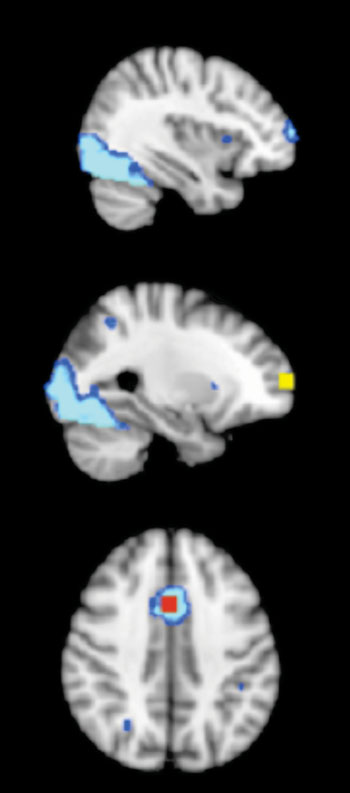Physically Fit Children Have More Robust Brain White Matter
By MedImaging International staff writers
Posted on 02 Sep 2014
A new study of 9- and 10-year-old children revealed that those who are more aerobically fit have more fibrous and compact white-matter tracts in the brain than their peers who are less fit. Posted on 02 Sep 2014
White matter of the brain is comprised of the bundles of axons that carry nerve signals from one brain region to another. More compact white matter is associated with faster and more efficient nerve activity.

Image: The 8-mm (diameter) box region of interests (ROIs) (1,000 mm3) in the frontal cortex, derived from an average activation map during incongruent, neutral and NoGo conditions of the task of cognitive control, across both physical activity and control child groups at pre-test and post-test (thresholded at Z > 6). Right anterior prefrontal cortex = yellow; ACC = red; average activation map = blue (Photo courtesy of Frontiers in Human Neuroscience journal).
The investigators reported their findings August 20, 2014, in the open-access journal Frontiers in Human Neuroscience. “Previous studies suggest that children with higher levels of aerobic fitness show greater brain volumes in gray-matter brain regions important for memory and learning,” said University of Illinois at Urbana-Champaign (USA) postdoctoral researcher Laura Chaddock-Heyman, who conducted the study with kinesiology and Community Health Professor Charles Hillman and Psychology Professor and Beckman Institute Director Arthur Kramer. “Now for the first time we explored how aerobic fitness relates to white matter in children's brains.”
The researchers used diffusion tensor imaging (DTI; also called diffusion magnetic resonance imaging [MRI]) to look at five white-matter tracts in the brains of the 24 participants. This method analyzes water diffusion into tissues. For white matter, less water diffusion means the tissue is more fibrous and compact, both desirable traits. They controlled for several variables, such as IQ, social and economic status, the timing of puberty, or a diagnosis of attention deficit hyperactivity disorder (ADHD) or other learning disabilities, which might have contributed to the reported fitness differences in the brain.
The analysis revealed substantial fitness-related disparities in the integrity of several white-matter tracts in the brain: the corpus callosum, which connects the brain’s left and right hemispheres; the superior longitudinal fasciculus, a pair of structures that connect the frontal and parietal lobes; and the superior corona radiata, which connect the cerebral cortex to the brain stem. “All of these tracts have been found to play a role in attention and memory,” Dr. Chaddock-Heyman said.
The investigators did not test for cognitive differences in the children in this study, but earlier research has demonstrated a link between improved aerobic fitness and increases in cognitive function on specific tasks and in academic settings. “Previous studies in our lab have reported a relationship between fitness and white-matter integrity in older adults,” Prof. Kramer said. “Therefore, it appears that fitness may have beneficial effects on white matter throughout the lifespan.”
To take the findings further, the researchers are now two years into a five-year randomized, controlled trial to determine whether white-matter tract integrity improves in children who begin a new physical fitness routine and maintain it over time. They are searching for alterations in aerobic fitness, brain structure and function, and genetic regulation. “Prior work from our laboratories has demonstrated both short- and long-term differences in the relation of aerobic fitness to brain health and cognition,” Prof. Hillman said. “However, our current randomized, controlled trial should provide the most comprehensive assessment of this relationship to date.”
The new findings add to the proof that aerobic exercise changes the brain in ways that enhance cognitive function, according to Dr. Chaddock-Heyman. “This study extends our previous work and suggests that white-matter structure may be one additional mechanism by which higher-fit children outperform their lower-fit peers on cognitive tasks and in the classroom,” she concluded.
Related Links:
University of Illinois at Urbana-Champaign










 Guided Devices.jpg)



